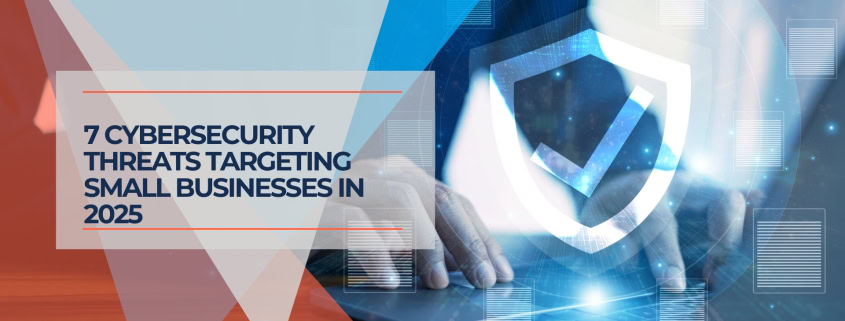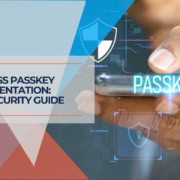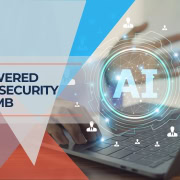Seven Critical Security Vulnerabilities Threatening Small Businesses in 2025
Your company's security system remains only as strong as its weakest component, and according to recent cybersecurity reports, this reality has become increasingly important for small businesses to address. Small businesses now face an evolved threat landscape that includes sophisticated cyber attacks targeting their operations, finances, and customer data.
Recent studies reveal that 43% of cyber attacks now target small businesses, with 60% of small businesses that suffer a cyberattack shutting down within six months. The financial impact has grown substantially, with the average total cost of a cyberattack on small businesses now $254,445, with some incidents costing up to $7 million.
The cybersecurity landscape has evolved significantly since traditional security measures were developed. Cybercriminals now leverage artificial intelligence, exploit remote work vulnerabilities, and conduct supply chain attacks that can bypass conventional defenses. Understanding these evolving threats and implementing modern security practices has become essential for business continuity.
Here are seven critical security vulnerabilities affecting small businesses in 2025 and the proven strategies to address them.
Table of Contents
- 1 Problem #1: AI-Powered Phishing and Deepfake Attacks
- 2 Problem #2: Ransomware-as-a-Service (RaaS) Proliferation
- 3 Problem #3: Supply Chain and Third-Party Vulnerabilities
- 4 Problem #4: Cloud Security Misconfigurations
- 5 Problem #5: Inadequate Identity and Access Management
- 6 Problem #6: Remote Work Security Gaps
- 7 Problem #7: Social Media and Digital Identity Theft
- 8 Building a Comprehensive Defense Strategy
- 9 Conclusion
Problem #1: AI-Powered Phishing and Deepfake Attacks
The emergence of AI-powered cybercrime represents a significant development in the current threat landscape. 67.4% of all phishing attacks in 2024 utilized some form of AI, with these attacks becoming increasingly difficult to distinguish from legitimate communications.
The Current Threat: Cybercriminals now use AI tools like ChatGPT to create well-crafted phishing emails with proper grammar, personalized content, and compelling narratives. Additionally, voice phishing attacks increased by 442% in late 2024 as deepfake technology enables attackers to impersonate executives, vendors, and trusted contacts through fake audio and video calls.
One notable example occurred when fraudsters used AI deepfakes to steal $25 million from UK engineering firm Arup during what employees believed was a legitimate video conference with senior management.
Solution: Implement Multi-Layered Verification
- Deploy advanced email filtering: Use AI-powered email security that can detect sophisticated phishing attempts
- Establish verification protocols: Require voice or in-person confirmation for any financial transactions or sensitive requests, regardless of apparent source
- Train employees regularly: Conduct monthly phishing simulations and educate staff about deepfake indicators such as unnatural facial expressions, lip-sync delays, or robotic speech patterns
- Use authentication badges: Implement tools that provide cryptographic verification of participant identity in video conferences
The FBI has specifically warned organizations about AI-powered phishing and voice cloning scams, emphasizing the need for enhanced verification procedures in business communications.
Problem #2: Ransomware-as-a-Service (RaaS) Proliferation
Ransomware-as-a-Service has grown by 60% in 2025, making ransomware tools more accessible to cybercriminals with varying skill levels. 55% of ransomware attacks hit businesses with fewer than 100 employees, with 75% of small businesses reporting they could not continue operating if hit with ransomware.
The Current Threat: RaaS platforms provide ready-made ransomware tools, infrastructure, and support, lowering the technical barrier for conducting attacks. These attacks often include double extortion tactics, where attackers both encrypt data and threaten to release sensitive information publicly.
Solution: Implement Comprehensive Ransomware Protection
- Deploy next-generation endpoint protection: Use AI-powered systems that can detect and stop ransomware before encryption begins
- Create immutable backups: Maintain offline, air-gapped backups that cannot be accessed or encrypted by attackers
- Segment networks: Implement microsegmentation to contain attacks and prevent lateral movement
- Develop incident response plans: Establish clear procedures for ransomware incidents, including communication protocols and recovery procedures
- Consider cyber insurance: Obtain comprehensive coverage that includes ransomware response and recovery costs
For businesses seeking comprehensive protection strategies, our small business cybersecurity guide provides detailed implementation frameworks.
Problem #3: Supply Chain and Third-Party Vulnerabilities
Supply chain attacks have increased by 431% between 2021 and 2023, with projections indicating continued growth through 2025. These attacks exploit business relationships between organizations and their vendors, software providers, or service partners.
The Current Threat: Attackers compromise legitimate software updates, cloud services, or vendor systems to gain access to multiple organizations simultaneously. Trusted vendors can inadvertently introduce vulnerabilities through outdated software, insufficient security controls, or compromised development environments.
Solution: Establish Robust Vendor Risk Management
- Conduct security assessments: Evaluate the cybersecurity posture of all vendors, partners, and contractors before engagement
- Include security clauses in contracts: Require compliance with specific security standards and regular security audits
- Monitor vendor access: Implement just-in-time privileged access for vendors and continuously monitor their activities
- Verify software integrity: Use code signing verification and vulnerability scanning for all third-party software
- Maintain vendor inventories: Keep updated records of all third-party relationships and their access levels
Problem #4: Cloud Security Misconfigurations
As businesses increasingly rely on cloud services, more than 8,000 servers were found vulnerable to data breaches due to misconfigurations in recent security assessments. These errors often occur during initial setup or when security settings are modified without proper oversight.
The Modern Threat: Common misconfigurations include using default passwords, failing to enable encryption, misconfigured access controls, and exposed storage buckets. These vulnerabilities can provide attackers with direct access to sensitive data without sophisticated attack techniques.
Solution: Implement Cloud Security Best Practices
- Use Infrastructure as Code (IaC): Automate cloud configurations to ensure consistent security settings
- Enable cloud security monitoring: Deploy tools that continuously scan for misconfigurations and compliance violations
- Implement least privilege access: Grant users and applications only the minimum permissions necessary for their functions
- Enable comprehensive logging: Monitor all cloud activities and set up alerts for suspicious behavior
- Regular security audits: Conduct quarterly reviews of cloud configurations and access permissions
Businesses planning cloud migrations should review our digital transformation guide for security-focused implementation strategies.
Problem #5: Inadequate Identity and Access Management
80% of all hacking incidents involve compromised credentials or passwords, making identity management failures one of the most exploited vulnerabilities. Only 20% of small businesses have implemented multi-factor authentication, leaving the majority vulnerable to credential-based attacks.
The Modern Threat: Password reuse, weak authentication methods, and failure to remove access for former employees create multiple entry points for attackers. Cybercriminals use automated tools to test stolen credentials across multiple systems, often gaining access to financial accounts, payroll systems, and sensitive data.
Solution: Deploy Strong Identity Security
- Mandate multi-factor authentication (MFA): Enable MFA for all business systems, prioritizing phishing-resistant methods like FIDO/WebAuthn authentication. The Cybersecurity and Infrastructure Security Agency (CISA) recommends phishing-resistant MFA strategies for the strongest protection against credential-based attacks.
- Use password managers: Provide enterprise password managers to generate and store unique, complex passwords for each account
- Implement Single Sign-On (SSO): Reduce password fatigue while maintaining security through centralized authentication
- Conduct regular access audits: Review user permissions quarterly and immediately disable accounts for departing employees
- Monitor for credential exposure: Use dark web monitoring to detect if employee credentials have been compromised
Organizations implementing AI-powered security solutions should explore AI tools for enhanced business security to strengthen their identity protection strategies.
Problem #6: Remote Work Security Gaps
The permanent shift to hybrid work has created new attack vectors that many businesses have not adequately addressed. Remote workers often use personal devices, unsecured networks, and cloud services without proper security controls.
The Modern Threat: Employees accessing business systems from home networks, coffee shops, or shared workspaces create multiple entry points for attackers. Personal devices may lack corporate security controls, and home networks typically have weaker security than business environments.
Solution: Secure the Remote Workforce
- Deploy Zero Trust architecture: Implement “never trust, always verify” principles that authenticate every connection regardless of location
- Provide secure devices: Issue company-managed devices with proper security configurations and endpoint protection
- Use VPN or SASE solutions: Ensure all remote connections route through secure, monitored channels
- Establish remote work policies: Create clear guidelines for secure remote work practices, including approved applications and network requirements
- Regular security training: Provide ongoing education about remote work risks and secure practices
For comprehensive remote work security implementation, review our remote work cybersecurity guide for detailed protocols and best practices.
Problem #7: Social Media and Digital Identity Theft
Social media account hacks pose significant risks to businesses, with attackers using compromised accounts to spread misinformation, conduct fraud, or gather intelligence for targeted attacks. Business social media accounts have become valuable targets for cybercriminals.
The Modern Threat: Attackers compromise business social media accounts to send fraudulent messages, promote scams, or damage brand reputation. They also use information gathered from social media profiles to craft convincing social engineering attacks against employees and customers.
Solution: Protect Digital Business Presence
- Secure all social media accounts: Enable MFA on all business social media accounts and use unique, strong passwords
- Limit administrative access: Restrict social media management to essential personnel only
- Monitor for impersonation: Regularly search for fake accounts using your business name or branding
- Employee social media policies: Establish guidelines for employee social media use to prevent information leakage
- Incident response for social media: Develop procedures for responding to compromised accounts or reputation attacks
Building a Comprehensive Defense Strategy
Successfully protecting your business requires implementing multiple security layers that work together to detect, prevent, and respond to threats. Key components include:
Immediate Actions:
- Enable MFA on all business accounts within 30 days
- Conduct employee security training within 60 days
- Perform a security audit of all cloud services and vendor relationships
- Implement automated backup systems with offline storage
Ongoing Security Practices:
- Monthly security training and phishing simulations
- Quarterly access reviews and vendor security assessments
- Regular security updates and patch management
- Continuous monitoring and threat detection
Investment Priorities: Modern businesses should allocate 10-15% of their IT budget to cybersecurity, focusing on employee training, advanced threat detection, and incident response capabilities.
For businesses planning comprehensive security improvements, consider partnering with experienced IT professionals who can assess your current vulnerabilities and implement appropriate security measures. Professional guidance can help prioritize investments and ensure proper implementation of security controls.
Conclusion
The cybersecurity threats facing small businesses in 2025 are more sophisticated and costly than in previous years. AI-powered attacks, ransomware-as-a-service, and supply chain vulnerabilities require updated security approaches that extend beyond traditional perimeter defenses.
Businesses that proactively implement comprehensive security measures can effectively defend against these threats. The key lies in adopting a multi-layered security strategy that combines current technology, employee training, and proper security processes.
The cost of implementing robust cybersecurity measures is typically much lower than the potential losses from a successful attack. With 60% of breached small businesses closing within six months, investing in proper security protects both data and business continuity.
By addressing these seven critical vulnerabilities and implementing the recommended solutions, your business can build resilience against the evolving threat landscape and maintain the trust of customers and partners.
Cybersecurity requires ongoing attention rather than one-time implementation. Start with the most critical vulnerabilities for your business and gradually build a comprehensive security program that evolves with emerging threats.
If you have questions about implementing these security measures or need assistance developing a cybersecurity strategy tailored to your business needs, professional consultation can provide the expertise and guidance necessary to protect your business effectively.











Leave a Reply
Want to join the discussion?Feel free to contribute!